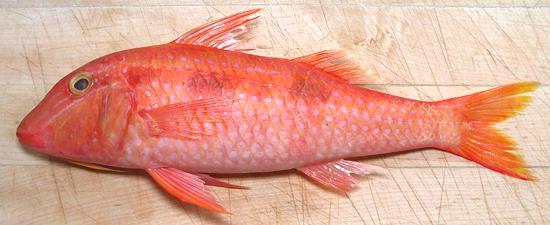 [Cá Phen Rau (market); Parupeneus insularis |
Double-bar Goatfish Parupeneus crassilabris]
[Cá Phen Rau (market); Parupeneus insularis |
Double-bar Goatfish Parupeneus crassilabris]
My identification of this fish as Two Saddle Goatfish is not certain, but is the best match Fishbase offers. The main discrepancy is that the forward saddle on my fish is a little farther aft than in the Fishbase photos. Goatfish are usually red when feeding at night. During the day they adopt completely different colors. Note that the two barbells which define "goatfish" are not extended and just visible under the chin in the photo.
The Two Saddle Goatfish is found in the Pacific from southern Japan to northeastern Australia, around almost all the Pacific Islands, including Hawaii, and a few may be found off the coast of Mexico and Central America. These fish can grow to nearly 12 inches, but the photo specimen was 10-3/4 inches and weighed 9-5/8 ounces. IUCN Read List LC (least concern).
The very similar Double-bar Goatfish can grow to almost 15 inches and is found along the far east coasts of the Indian Ocean, but it doesn't go nearly as far into the Pacific Islands, only as far as Tonga.
More on Goatfish.
Cooking: This is an excellent eating fish, with mild white flesh that has enough flavor to be interesting. It can be pan fried with a light dusting of rice flour. It can be briefly poached but will flake apart with longer wet cooking. I do not cook this fish whole or pan dressed because of the many centerline pin bones and other small bones associated with the fins, as well as extreme skin shrink.
This fish does have a skin problem. The skin is very thin and difficult to remove, but has very strong shrink, which the flesh is too tender to resist. It can be pan fried skin-on by frying until almost done before turning skin side down. Pressing it down with the turner will flatten it some, but skin shrink will narrow and thicken the fillet.
A fillet poached skin-on will roll into tube. Since I poach much more often than frying, I simply cut the fillet down the centerline. The two strips do curl some, flaking the fish, but the skin holds the flakes in place so it's bit puffy looking and takes sauces very well.
Buying: I purchased the photo specimen from a large Vietnamese / Chinese market in Los Angeles (San Gabriel), for 2019 US $5.69 / pound. It is not common - you just buy it when you see it.
Scales: This fish is covered with very large but rather thin scales with moderate adhesion - they fly about quite a bit when scaling. The main problem is they are very transparent and making sure you've got them all needs care - scratching the fish backwards with a fingernail, particularly along the fins, will find them all.
Cleaning: This fish has a small body cavity and is easy to clean, but the throat is so strong you'll have to cut it with shears. The gills pull out quite hard. The blood works under the backbone is difficult to get at due to the backbone being prickly.
Fillets: This is an easy fish to fillet, but the short rib cage is difficult to follow. When you get to the rib cage just use your kitchen shears to cut the ribs from the backbone and use long nose pliers to pull them from the fillet. There are also many very significant centerline pin bones which need to be pulled for the front 2/3 of the fillet. I counted 11 pin bones per fillet. They are easy to find in the soft flesh, just pull them straight forward with long nose pliers.
Skin: The skin of this fish does not have a strong or "off" flavor but it does shrink very strongly. It is difficult to skin this fish because the skin is so thin and fragile. Using the standard Method, you have to hold the long knife at as shallow an angle as you can without taking flesh, and you'll still probably end up with fairly large patches of skin remaining. If it breaks half way, start over from the tip of the fillet at the top. Don't worry about modest size patches, they'll cause no trouble, but if you have a really big patch, you may be able to get under the transparent outer membrane with your filleting knife and pull it off - that's the part that shrinks, not the color layer under it. see Cooking above for hints for using this fish skin-on.
Stock: The heads, fins, bones made a rather milky stock, which is probably because, while I was distracted, the pot came to a full boil for an unknown number of minutes. Other goatfish make good stock, so this one might do so also.
sf_goatpz 190716 - www.clovegarden.com